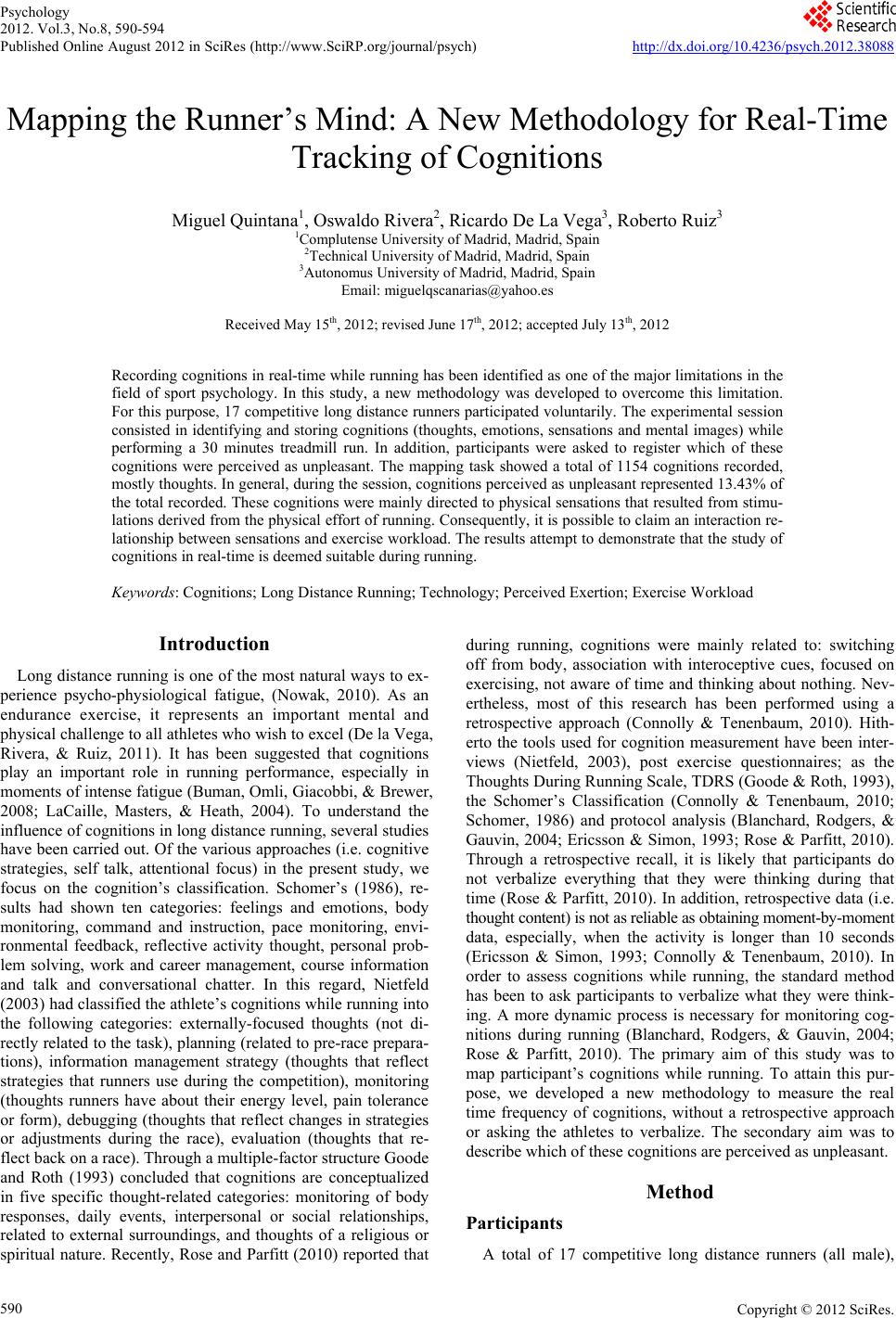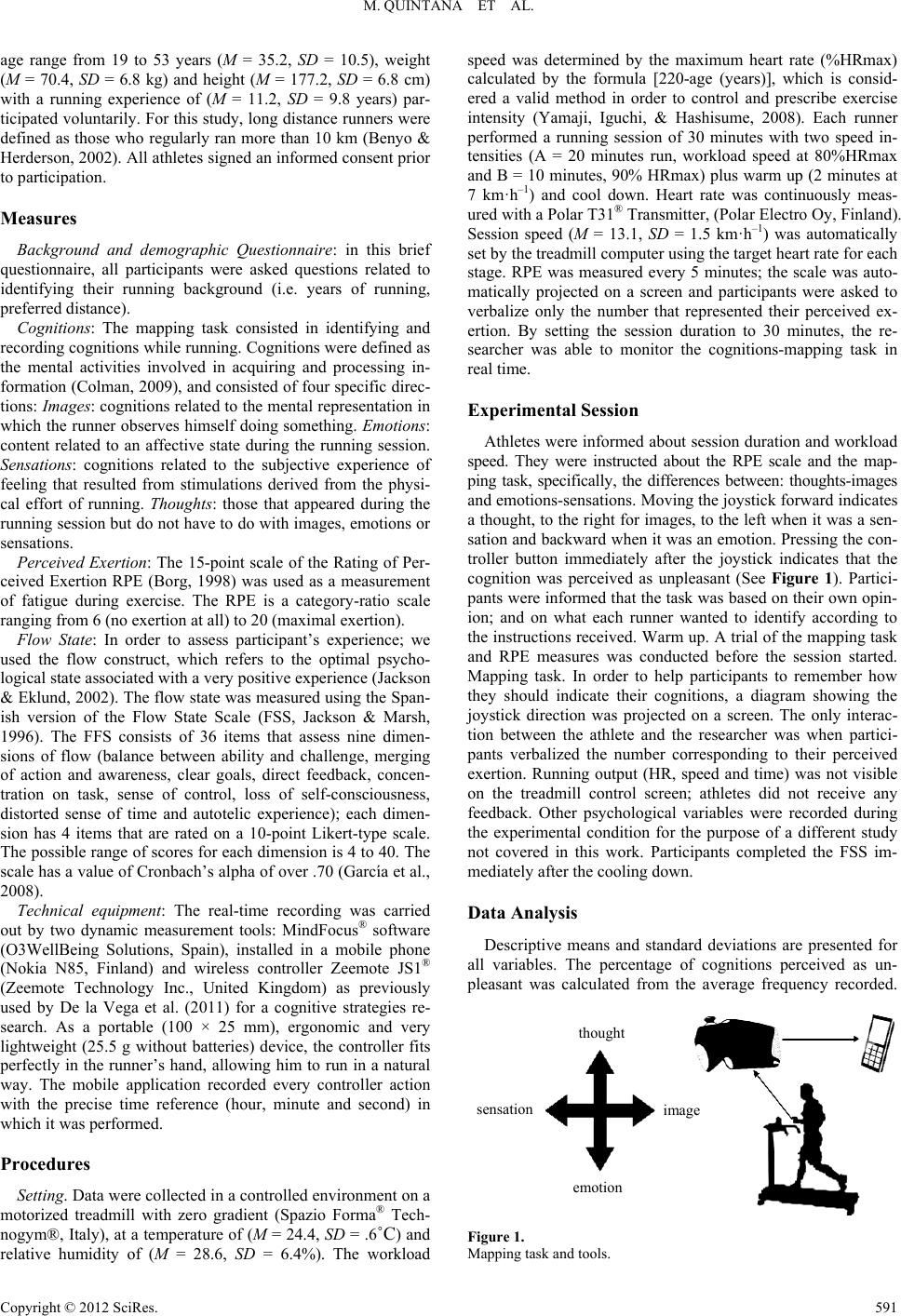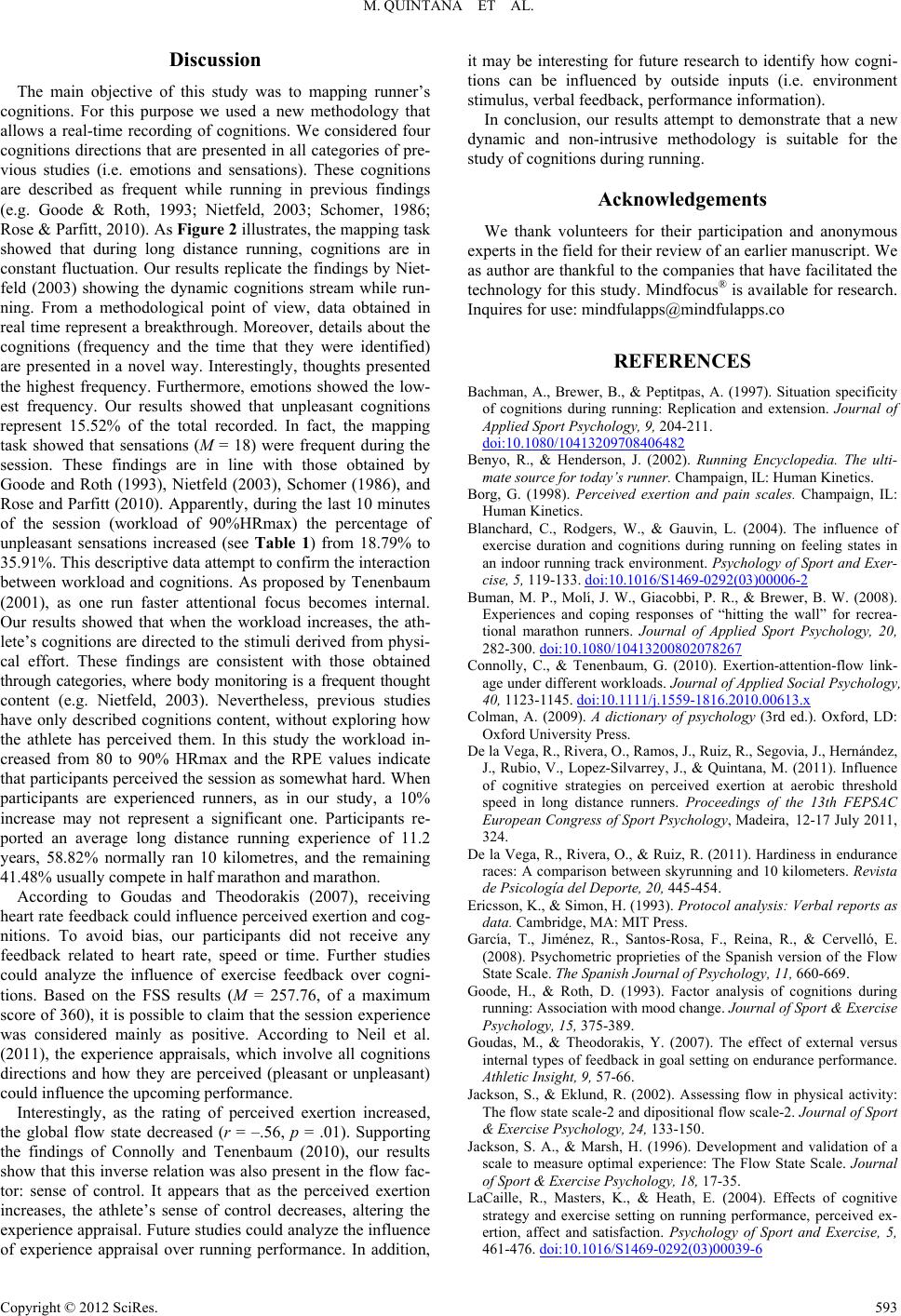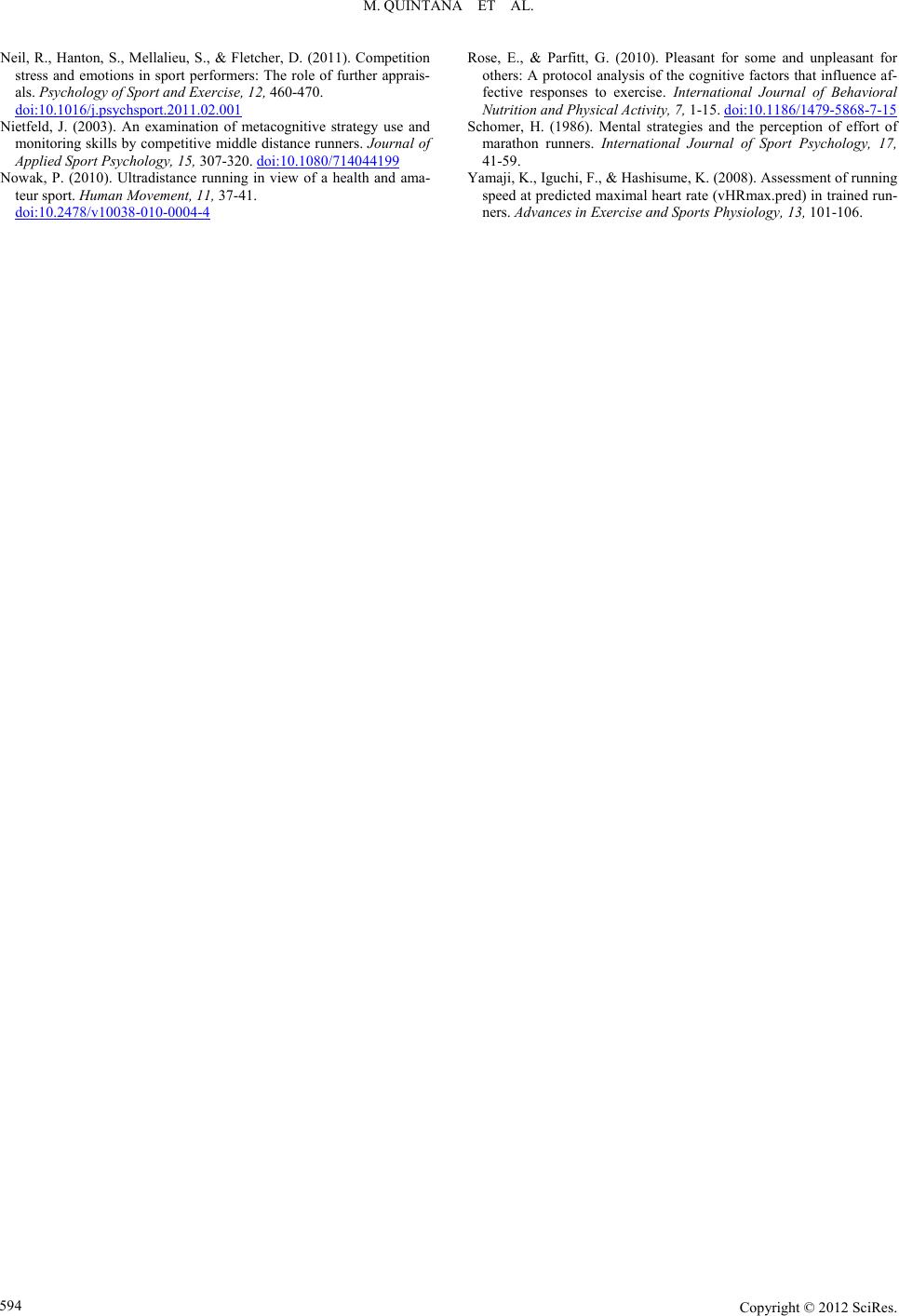Paper Menu >>
Journal Menu >>
 Psychology 2012. Vol.3, No.8, 590-594 Published Online August 2012 in SciRes (http://www.SciRP.org/journal/psych) http://dx.doi.org/10.4236/psych.2012.38088 Copyright © 2012 SciRes. 590 Mapping the Runner’s Mind: A New Methodology for Real-Time Tracking of Cognitions Miguel Qui nt ana 1, O swaldo Rivera 2, Ricardo De La Vega3, Roberto Ruiz3 1Complutense University of Madrid, Madrid, Spain 2Technical University of Madrid, Madrid, Spain 3Autonomus University of Madrid, Madrid, Spain Email: miguelqscanarias@yahoo.es Received May 15th, 2012; revised June 17th, 2012; a ccepted July 13th, 2012 Recording cognitions in real-time while running has been identified as one of the major limitations in the field of sport psychology. In this study, a new methodology was developed to overcome this limitation. For this purpose, 17 competitive long distance runners participated voluntarily. The experimental session consisted in identifying and storing cognitions (thoughts, emotions, sensations and mental images) while performing a 30 minutes treadmill run. In addition, participants were asked to register which of these cognitions were perceived as unpleasant. The mapping task showed a total of 1154 cognitions recorded, mostly thoughts. In general, during the session, cognitions perceived as unpleasant represented 13.43% of the total recorded. These cognitions were mainly directed to physical sensations that resulted from stimu- lations derived from the physical effort of running. Consequently, it is possible to claim an interaction re- lationship between sensations and exercise workload. The results attempt to demonstrate that the study of cognitions in real-time is deemed suitable during running. Keywords: Cognitions; Long Distance Running; Technology; Perceived Exertion; Exercise Workload Introduction Long distance running is one of the most natural ways to ex- perience psycho-physiological fatigue, (Nowak, 2010). As an endurance exercise, it represents an important mental and physical challenge to all athletes who wish to excel (De la Vega, Rivera, & Ruiz, 2011). It has been suggested that cognitions play an important role in running performance, especially in moments of intense fatigue (Buman, Omli, Giacobbi, & Brewer, 2008; LaCaille, Masters, & Heath, 2004). To understand the influence of cognitions in long distance running, several studies have been carried out. Of the various approaches (i.e. cognitive strategies, self talk, attentional focus) in the present study, we focus on the cognition’s classification. Schomer’s (1986), re- sults had shown ten categories: feelings and emotions, body monitoring, command and instruction, pace monitoring, envi- ronmental feedback, reflective activity thought, personal prob- lem solving, work and career management, course information and talk and conversational chatter. In this regard, Nietfeld (2003) had classified the athlete’s cognitions while running into the following categories: externally-focused thoughts (not di- rectly related to the task), planning (related to pre-race prepara- tions), information management strategy (thoughts that reflect strategies that runners use during the competition), monitoring (thoughts runners have about their energy level, pain tolerance or form), debugging (thoughts that reflect changes in strategies or adjustments during the race), evaluation (thoughts that re- flect back on a race). Through a multiple-factor structure Goode and Roth (1993) concluded that cognitions are conceptualized in five specific thought-related categories: monitoring of body responses, daily events, interpersonal or social relationships, related to external surroundings, and thoughts of a religious or spiritual nature. Recently, Rose and Parfitt (2010) reported that during running, cognitions were mainly related to: switching off from body, association with interoceptive cues, focused on exercising, not aware of time and thinking about nothing. Nev- ertheless, most of this research has been performed using a retrospective approach (Connolly & Tenenbaum, 2010). Hith- erto the tools used for cognition measurement have been inter- views (Nietfeld, 2003), post exercise questionnaires; as the Thoughts During Running Scale, TDRS (Goode & Roth, 1993), the Schomer’s Classification (Connolly & Tenenbaum, 2010; Schomer, 1986) and protocol analysis (Blanchard, Rodgers, & Gauvin, 2004; Ericsson & Simon, 1993; Rose & Parfitt, 2010). Through a retrospective recall, it is likely that participants do not verbalize everything that they were thinking during that time (Rose & Parfitt, 2010). In addition, retrospective data (i.e. thought content) is not as reliable as obtaining moment-by-moment data, especially, when the activity is longer than 10 seconds (Ericsson & Simon, 1993; Connolly & Tenenbaum, 2010). In order to assess cognitions while running, the standard method has been to ask participants to verbalize what they were think- ing. A more dynamic process is necessary for monitoring cog- nitions during running (Blanchard, Rodgers, & Gauvin, 2004; Rose & Parfitt, 2010). The primary aim of this study was to map participant’s cognitions while running. To attain this pur- pose, we developed a new methodology to measure the real time frequency of cognitions, without a retrospective approach or asking the athletes to verbalize. The secondary aim was to describe which of these cognitions are perceived as unpleasant. Method Participants A total of 17 competitive long distance runners (all male),  M. QUINTANA ET AL. age range from 19 to 53 years (M = 35.2, SD = 10.5), weight (M = 70.4, SD = 6.8 kg) and height (M = 177.2, SD = 6.8 cm) with a running experience of (M = 11.2, SD = 9.8 years) par- ticipated voluntarily. For this study, long distance runners were defined as those who regularly ran more than 10 km (Benyo & Herderson, 2002). All athletes signed an informed consent prior to participation. Measures Background and demographic Questionnaire: in this brief questionnaire, all participants were asked questions related to identifying their running background (i.e. years of running, preferred distance). Cognitions: The mapping task consisted in identifying and recording cognitions while running. Cognitions were defined as the mental activities involved in acquiring and processing in- formation (Colman, 2009), and consisted of four specific direc- tions: Images: cognitions related to the mental representation in which the runner observes himself doing something. Emotions: content related to an affective state during the running session. Sensations: cognitions related to the subjective experience of feeling that resulted from stimulations derived from the physi- cal effort of running. Thoughts: those that appeared during the running session but do not have to do with images, emotions or sensations. Perceived Exertion: The 15-point scale of the Rating of Per- ceived Exertion RPE (Borg, 1998) was used as a measurement of fatigue during exercise. The RPE is a category-ratio scale ranging from 6 (no exertion at all) to 20 (maximal exertion). Flow State: In order to assess participant’s experience; we used the flow construct, which refers to the optimal psycho- logical state associated with a very positive experience (Jackson & Eklund, 2002). The flow state was measured using the Span- ish version of the Flow State Scale (FSS, Jackson & Marsh, 1996). The FFS consists of 36 items that assess nine dimen- sions of flow (balance between ability and challenge, merging of action and awareness, clear goals, direct feedback, concen- tration on task, sense of control, loss of self-consciousness, distorted sense of time and autotelic experience); each dimen- sion has 4 items that are rated on a 10-point Likert-type scale. The possible range of scores for each dimension is 4 to 40. The scale has a value of Cronbach’s alpha of over .70 (García et al., 2008). Technical equipment: The real-time recording was carried out by two dynamic measurement tools: MindFocus® software (O3WellBeing Solutions, Spain), installed in a mobile phone (Nokia N85, Finland) and wireless controller Zeemote JS1® (Zeemote Technology Inc., United Kingdom) as previously used by De la Vega et al. (2011) for a cognitive strategies re- search. As a portable (100 × 25 mm), ergonomic and very lightweight (25.5 g without batteries) device, the controller fits perfectly in the runner’s hand, allowing him to run in a natural way. The mobile application recorded every controller action with the precise time reference (hour, minute and second) in which it was performed. Procedures Setting. Data were collected in a controlled environment on a motorized treadmill with zero gradient (Spazio Forma® Tech- nogym®, Italy), at a temperature of (M = 24.4, SD = .6˚C) an d relative humidity of (M = 28.6, SD = 6.4%). The workload speed was determined by the maximum heart rate (%HRmax) calculated by the formula [220-age (years)], which is consid- ered a valid method in order to control and prescribe exercise intensity (Yamaji, Iguchi, & Hashisume, 2008). Each runner performed a running session of 30 minutes with two speed in- tensities (A = 20 minutes run, workload speed at 80%HRmax and B = 10 minutes, 90% HRmax) plus warm up (2 minutes at 7 km·h–1) and cool down. Heart rate was continuously meas- ured with a Polar T31® Transmitter, (Polar Electro Oy, Finland). Session speed (M = 13.1, SD = 1.5 km·h–1) was automatically set by the treadmill computer using the target heart rate for each stage. RPE was measured every 5 minutes; the scale was auto- matically projected on a screen and participants were asked to verbalize only the number that represented their perceived ex- ertion. By setting the session duration to 30 minutes, the re- searcher was able to monitor the cognitions-mapping task in real time. Experimental Session Athletes were informed about session duration and workload speed. They were instructed about the RPE scale and the map- ping task, specifically, the differences between: thoughts-images and emotions-sensations. Moving the joystick forward indicates a thought, to the right for images, to the left when it was a sen- sation and backward when it was an emotion. Pressing the con- troller button immediately after the joystick indicates that the cognition was perceived as unpleasant (See Figure 1). Partici- pants were informed that the task was based on their own opin- ion; and on what each runner wanted to identify according to the instructions received. Warm up. A trial of the mapping task and RPE measures was conducted before the session started. Mapping task. In order to help participants to remember how they should indicate their cognitions, a diagram showing the joystick direction was projected on a screen. The only interac- tion between the athlete and the researcher was when partici- pants verbalized the number corresponding to their perceived exertion. Running output (HR, speed and time) was not visible on the treadmill control screen; athletes did not receive any feedback. Other psychological variables were recorded during the experimental condition for the purpose of a different study not covered in this work. Participants completed the FSS im- mediately after the cooling down. Data Analysis Descriptive means and standard deviations are presented for all variables. The percentage of cognitions perceived as un- pleasant was calculated from the average frequency recorded. thought sensation image emotion Figure 1. Mapping task and tools. Copyright © 2012 SciRes. 591  M. QUINTANA ET AL. Copyright © 2012 SciRes. 592 Rating of perceived exertion. Perceived exertion range was from 9.67 to 15.33 (M = 12.89, SD = 1.52), which represents a somewhat hard effort (Borg, 1998). In addition, to explore the relation between perceived exertion and flow state, Spearman’s rank correlation coefficient was used. Significance level was (p < .05). Participants’ experience. FSS showed an average global flow state of 257.76 (SD = 37.47). This result represents 71.6% of a maximum scale score of 360. This percentage suggests that articipant’s session appraisal was mainly positive. Spearman’s rank correlation coefficient showed that as the rating of per- ceived exertion increases the global flow state decreases (r = –.56, p = .01). This inverse relation was present also in the flow factors of balance between ability and challenge (r = –.61, p = .009), clear goals (r = –.52, p = .03), clear, direct feedback (r = –.63, p = .006) and sense of control (r = –.51, p = .03). Results Mapping Task. A new methodology was developed in order to map participant’s cognitions while running. The mapping task showed a total of 1154 cognitions recorded (M = 67.88, SD = 40.06). Average cognition frequency recorded during the session is presented in Figure 2. Participants identified and registered an average of 58.76 (SD = 37.63) cognitions, distributed as follows: thoughts (M = 31.06, SD = 23.23), images (M = 13.05, SD = 10.25), emotions (M = 7.29, SD = 5.25) and sensations (M = 18, SD = 13.36). Table 1. Figure 3 illustrates the fluctuation of unpleasant cognitions during the session. Unpleasant cognitions (M = 9.12, SD = 8.03), 15.52% of the total recorded, were distributed into: thoughts (M = 3. 88, SD = 3.77) representing 12.49 %, images (M = .65, SD = 1.05) 4.86%, emotions (M = .71, SD = .92) 9.73% and sensations (M = 4.82, SD = 5.91) 26.77%, which represents the highest percentage. In general, the mapping task shows that during the session unpleasant cognitions (N = 155) represents 13.43% of the total recorded. Cognitions frequency. A (80%HRmax) B (90%HRmax) Cognitions Unpleasanta Cognitions Unpleasanta M (SD) Thoughts19.35 (14.16)2.06 (2. 35) 11.76 (10.01) 1.88 (2.14) Emotions 4.29 (3.96) .52 (.94) 3 (2.52) .17 (.39) Images 8.17 (5.96 ) .41 (.6 1) 5.17 (5.55) .35 (.60) Sensations 10.64 (9.20)2 (3.14) 7.35 (6.14) 2.64 (3.74) The frequency analysis showed in Table 1, reveals that dur- ing the first 20 minutes, 18.79% of the sensations registered were perceived as unpleasant, this percentage increases to 35.91% in the last 10 minutes. Note: aIndividual’s perception. Co g nitions Ma pp in g 0 1 2 3 4 24681012 14 16 18 2022 24 26 28 30 80% HR max90% HR max Time (min) A verage C ogn iti ons Frequency Thoughts Emotions Images Sensations Figure 2. Average cognition frequency calculated every two minutes. Un p leasant Co g nitions Ma pp in g 24681012141618202224262830 80% HR max90% HR max Time (min) 1 0.8 0.6 0.4 0.2 0 Unpleasant ThoughtsUnpleasant EmotionsUnp leas ant ImagesUnp leasant S ensatio ns Figure 3. Average cognitions perce ived as unpleasant calculated every two minutes.  M. QUINTANA ET AL. Discussion The main objective of this study was to mapping runner’s cognitions. For this purpose we used a new methodology that allows a real-time recording of cognitions. We considered four cognitions directions that are presented in all categories of pre- vious studies (i.e. emotions and sensations). These cognitions are described as frequent while running in previous findings (e.g. Goode & Roth, 1993; Nietfeld, 2003; Schomer, 1986; Rose & Parfitt, 2010). As Figure 2 illustrates, the mapping task showed that during long distance running, cognitions are in constant fluctuation. Our results replicate the findings by Niet- feld (2003) showing the dynamic cognitions stream while run- ning. From a methodological point of view, data obtained in real time represent a breakthrough. Moreover, details about the cognitions (frequency and the time that they were identified) are presented in a novel way. Interestingly, thoughts presented the highest frequency. Furthermore, emotions showed the low- est frequency. Our results showed that unpleasant cognitions represent 15.52% of the total recorded. In fact, the mapping task showed that sensations (M = 18) were frequent during the session. These findings are in line with those obtained by Goode and Roth (1993), Nietfeld (2003), Schomer (1986), and Rose and Parfitt (2010). Apparently, during the last 10 minutes of the session (workload of 90%HRmax) the percentage of unpleasant sensations increased (see Table 1) from 18.79% to 35.91%. This descriptive data attempt to confirm the interaction between workload and cognitions. As proposed by Tenenbaum (2001), as one run faster attentional focus becomes internal. Our results showed that when the workload increases, the ath- lete’s cognitions are directed to the stimuli derived from physi- cal effort. These findings are consistent with those obtained through categories, where body monitoring is a frequent thought content (e.g. Nietfeld, 2003). Nevertheless, previous studies have only described cognitions content, without exploring how the athlete has perceived them. In this study the workload in- creased from 80 to 90% HRmax and the RPE values indicate that participants perceived the session as somewhat hard. When participants are experienced runners, as in our study, a 10% increase may not represent a significant one. Participants re- ported an average long distance running experience of 11.2 years, 58.82% normally ran 10 kilometres, and the remaining 41.48% usually compete in half marathon and marathon. According to Goudas and Theodorakis (2007), receiving heart rate feedback could influence perceived exertion and cog- nitions. To avoid bias, our participants did not receive any feedback related to heart rate, speed or time. Further studies could analyze the influence of exercise feedback over cogni- tions. Based on the FSS results (M = 257.76, of a maximum score of 360), it is possible to claim that the session experience was considered mainly as positive. According to Neil et al. (2011), the experience appraisals, which involve all cognitions directions and how they are perceived (pleasant or unpleasant) could influence the upcoming performance. Interestingly, as the rating of perceived exertion increased, the global flow state decreased (r = –.56, p = .01). Supporting the findings of Connolly and Tenenbaum (2010), our results show that this inverse relation was also present in the flow fac- tor: sense of control. It appears that as the perceived exertion increases, the athlete’s sense of control decreases, altering the experience appraisal. Future studies could analyze the influence of experience appraisal over running performance. In addition, it may be interesting for future research to identify how cogni- tions can be influenced by outside inputs (i.e. environment stimulus, verbal feedback, performance information). In conclusion, our results attempt to demonstrate that a new dynamic and non-intrusive methodology is suitable for the study of cognitions during running. Acknowledgements We thank volunteers for their participation and anonymous experts in the field for their review of an earlier manuscript. We as author are thankful to the companies that have facilitated the technology for this study. Mindfocus® is available for research. Inquires for use: mindfulapps@mindfulapps.co REFERENCES Bachman, A., Brewer, B., & Peptitpas, A. (1997). Situation specificity of cognitions during running: Replication and extension. Journal of Applied Sport Psychology, 9, 204-211. doi:10.1080/10413209708406482 Benyo, R., & Henderson, J. (2002). Running Encyclopedia. The ulti- mate source for today’s runner. Champaign, IL: Human Kinetics. Borg, G. (1998). Perceived exertion and pain scales. Champaign, IL: Human Kinetics. Blanchard, C., Rodgers, W., & Gauvin, L. (2004). The influence of exercise duration and cognitions during running on feeling states in an indoor running track environment. Psychology of Sport and Exer- cise, 5, 119-133. doi:10.1016/S1469-0292(03)00006-2 Buman, M. P., Molí, J. W., Giacobbi, P. R., & Brewer, B. W. (2008). Experiences and coping responses of “hitting the wall” for recrea- tional marathon runners. Journal of Applied Sport Psychology, 20, 282-300. doi:10.1080/10413200802078267 Connolly, C., & Tenenbaum, G. (2010). Exertion-attention-flow link- age under different workloads. Journal of Applied Social Psychology, 40, 1123-1145. doi:10.1111/j.1559-1816.2010.00613.x Colman, A. (2009). A dictionary of psychology (3rd ed.). Oxford, LD: Oxford University Press. De la Vega, R., Rivera, O., Ramos, J., Ruiz, R., Segovia, J., Hernández, J., Rubio, V., Lopez-Silvarrey, J., & Quintana, M. (2011). Influence of cognitive strategies on perceived exertion at aerobic threshold speed in long distance runners. Proceedings of the 13th FEPSAC European Congress of Sport Psychology, Madeira, 12-17 July 2011, 324. De la Vega, R., Rivera, O., & Ruiz, R. (2011). Hardiness in endurance races: A comparison between skyrunning and 10 kilometers. Revista de Psicología del Deporte, 20, 445-454. Ericsson, K., & Simon, H. (1993). Protocol analysis: Verbal reports as data. Cambridge, MA: MIT Press. García, T., Jiménez, R., Santos-Rosa, F., Reina, R., & Cervelló, E. (2008). Psychometric proprieties of the Spanish version of the Flow State Scale. The Spanish Journal of Psychology, 11, 660-669. Goode, H., & Roth, D. (1993). Factor analysis of cognitions during running: Association with mood change. Journal of Sport & Exercise Psychology, 15, 375-389. Goudas, M., & Theodorakis, Y. (2007). The effect of external versus internal types of feedback in goal setting on endurance performance. Athletic Insight, 9, 57-66. Jackson, S., & Eklund, R. (2002). Assessing flow in physical activity: The flow state scale-2 and dipositional flow scale-2. Journal of Sport & Exercise Psychology, 24, 133-150. Jackson, S. A., & Marsh, H. (1996). Development and validation of a scale to measure optimal experience: The Flow State Scale. Journal of Sport & Exercise Psycholo gy , 18, 17-35. LaCaille, R., Masters, K., & Heath, E. (2004). Effects of cognitive strategy and exercise setting on running performance, perceived ex- ertion, affect and satisfaction. Psychology of Sport and Exercise, 5, 461-476. doi:10.1016/S1469-0292(03)00039-6 Copyright © 2012 SciRes. 593  M. QUINTANA ET AL. Neil, R., Hanton, S., Mellalieu, S., & Fletcher, D. (2011). Competition stress and emotions in sport performers: The role of further apprais- als. Psychology of Sport and Exercise, 12, 460-470. doi:10.1016/j.psychsport.2011.02.001 Nietfeld, J. (2003). An examination of metacognitive strategy use and monitoring skills by competitive middle distance runners. Journal of Applied Sport Psychology, 15, 307-320. doi:10.1080/714044199 Nowak, P. (2010). Ultradistance running in view of a health and ama- teur sport. Human Movement, 11, 37-41. doi:10.2478/v10038-010-0004-4 Rose, E., & Parfitt, G. (2010). Pleasant for some and unpleasant for others: A protocol analysis of the cognitive factors that influence af- fective responses to exercise. International Journal of Behavioral Nutrition and Physical Activity, 7, 1-15. doi:10.1186/1479-5868-7-15 Schomer, H. (1986). Mental strategies and the perception of effort of marathon runners. International Journal of Sport Psychology, 17, 41-59. Yamaji, K., Iguchi, F., & Hashisume, K. (2008). Assessment of running speed at predicted maximal heart rate (vHRmax.pred) in trained run- ners. Advances in Exercise and Sports Physiology, 13, 101-106. Copyright © 2012 SciRes. 594 |

